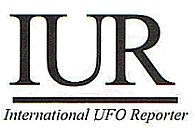
|
By Michael D. Swords |
INTELLIGENT MOTIONS

|
By Michael D. Swords |
In late 1951 and into 1952, there was a sea change in the Pentagon. When Gen. William M. Garland became chief assistant to the new Director of Air Force Intelligence, Maj. Gen. John A. Samford, the barriers to sympathetic consideration of UFO reality cleared away. Previously, there had been three consistently negative individuals there: Brig. Gen. Ernest (Mickey) Moore, one of Lieut. Gen. Charles P. Cabell's main assistants; Col. Edward Porter, the most derisive figure in the analysis staff; and Maj. Aaron (Jerry) Boggs, who manned the UFO analysis desk.
When Samford and Garland came in, Moore was gone and so was Boggs. Porter was more or less kicked upstairs as some sort of liaison to the Joint Chiefs, and though still present, was not so much an active blocker of UFO work. Instead, the colonel just below him in the intelligence stack, William A. Adams, brought an extremely positive voice to the issue. Most important for our story, Boggs's position, briefly held by a station keeper, had now been given to Maj. Dewey Fournet.
Capt. Edward Ruppelt said that Fournet and his boss (Adams) were two of the most convinced voices anywhere in Air Force Intelligence that the UFOs were extraterrestrial technology. For once there was some freedom to creatively probe into this mystery. But what to do? The Air Force would not spend money on the problem. Even operating in-place systems would or could not be dedicated in any significant way to the task. But Fournet found a different means.
Dewey Fournet was an intelligent man, a pilot, and an engineer. When he looked at the UFO reports that came across his desk, he was astonished not only by what they were telling him but also by the close-minded resistance that many Pentagon officers had to even the thought that they might be extraterrestrial technology. He found it frustrating that anyone could be even mildly familiar with these reports and still not have the ETH on the table. He undertook his legendary Top Secret study not to prove the ETH, but to break down what he felt were foolish and potentially unhelpful mental blocks to something that could turn out to be the solution to these incidents.
Fournet was almost always conservative in discussing his beliefs and his role once he left the service. But we have several enlightening comments by Ed Ruppelt about him. We can probably trust those remarks, as Fournet was aware of them, and many times referred to Ruppelt as a good colleague and an honest man. Let's listen to Ruppelt talking about him:
Dewey Fournet was our liaison officer in the Pentagon. He was probably the most thoroughly convinced believer that UFOs were interplanetary spaceships that I knew. We used to argue for hours every time I went to Washington. He was the ringleader of the group in the Directorate of Intelligence that believed. His "Top Secret" study created a lot of excitement by concluding that UFOs were spaceships. He was thoroughly hacked about the decision of the [Robertson] panel, and he was the unidentified source of a lot of Keyhoe's information. . . . Dewey's word swung a lot of weight in the D/I.
He had access to all of our reports, read them all over very carefully, and was still absolutely convinced. He and I used to argue by the hour and I must say that he had some good arguments. Everything that he believed was based on the "face value" of the reports. If a person said that they saw something and had a good description of it, Dewey took this as the last word. We disagreed when I didn't buy the reports lock, stock, and barrel. ... No matter how much I talked, however, I never convinced Fournet that I had a point.
In about December of 1952, Dewey made a study of UFOs. It was good except for this basic premise. [Ruppelt is here alluding to Fournet accepting witness testimony in ways that were, to him, too simplistic.] He and I hashed it around a lot. He gave it to a lot of people who believed it because Dewey had a good reputation.... His famous study threw the D/I in a tizzy.
This study was undertaken by Fournet in the fall of 1952 and written in an almost polished report in December, shortly before he left the service. He later said that he knew that it was completed and classified Top Secret, but he himself never saw the final copy. He took several of the cases that he used in this study and went with them to make a presentation to the famous Robertson Panel, hoping to loosen up thinking about the ETH. There the mystery of the study resided, a "hopeless task" of retrieval for UFO historians, just like its legendary cousin, the 1948 Estimate of the Situation.
FOURNET REVEALED
We are still largely in the dark about the Estimate, but a significant chunk of the Fournet study has surfaced. This happened, surprisingly, through the auspices of the CIA.
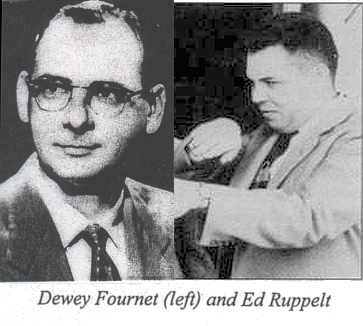 |
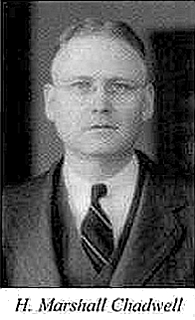
|
The CIA has released a small but interesting pile of documents that are mainly concerned with the aftereffects of the 1952 Washington, D.C., sightings, specifically the CIA's scrambling to try to understand UFOs and the run-up to the Robertson Panel. In those documents we read many things. One topic concerned the great interest that a group of scientists at the Massachusetts Institute of Technology (primarily the core people who would establish MIT's Lincoln Laboratory) were showing in UFOs, and the possibility that they would launch a full-scale study in concert with the CIA's Office of Scientific Intelligence. OSI Director H. Marshall Chadwell was handling all these correspondences, meetings, and (with CIA rocket scientist Fred Durant) arrangements for the panel. His correspondence with the Lincoln group was with MIT physicist Julius A. Stratton, a science super-heavyweight. Chadwell had almost promised that some such cooperation would be likely once the panel meeting was out of the way.
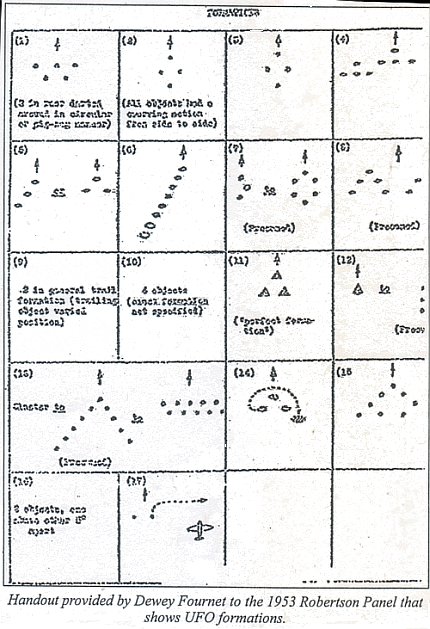
Of course, that didn't happen. It appears that Chadwell had the rug pulled out from under his plans at the eleventh hour. But he had to tell Stratton what happened, and that's where Fournet's study comes in. In Chadwell's January 27, 1953, letter to Stratton, there is a lot of talk about the meeting, and, at the end, with no ceremony, is attached a page that is obviously a handout (above) that Chadwell got at the Panel meeting. It is labeled “UFO Formations,” and on the previous page was scrawled, “Basis for Maj. Fournet's presentation to OSI Advisory Grp.”
When UFO researcher Jan Aldrich saw this page, he immediately knew what it was. A few months later, it dawned on me, too. These were diagrams that Dewey would give to Robertson et al. to help them follow along while he explained his study. They probably represent only part of the total study, but this is what we have to work with. CUFOS board member Bill Murphy, with sharper eyes than mine, saw the probable spellings of most of the words on the diagrams. Then it was up to the rest of us to see what we might see.
This is what I saw. You are welcome to tell me that I am wrong. Case #6 was obviously the Nash/Fortenberry sighting over Chesapeake Bay on July 14, 1952 (see IUR 27, no. 1, Spring 2002). Case #1 seemed almost as obviously the May 1, 1952, George Air Force Base case near Victorville, California. CUFOS historian Frank John Reid instantly showed me that Case #11 was the July 24, 1952, Carson Sink, Nevada, B-25 case. Looking at those and the grid, I made a hypothesis:
a) these things could be in date order — that's the sort of thing an organized engineer would do; and
b) these cases might all be within the time period when Fournet had sole responsibility for the Pentagon UFO desk — that is, they were in some sense “his” cases.
Using those two guesses as guidelines, on these pages I have (partially) reconstructed Fournet's study as he presented it to Robertson.
THE FALLOUT FROM FOURNET
What we've been able to do so far has several positive elements for UFO studies. First, it proves irrevocably that Fournet's study was real and that the Air Force continually lied about this. Second, it proves that things of importance are not being released, even when directly asked for through FOIA. Third, it indicates that important cases were never dealt with by Blue Book, even the relatively competent Blue Book headed by Ruppelt. To illustrate this point, take Case #13 from Albuquerque, New Mexico, on July 30, 1952. The diagram is relatively elaborate and so perfectly matches the witness description that there is no reasonable doubt about it. But this case does not appear in Blue Book. (I will hold out a small caveat on this, as Blue Book was often sloppy and disorganized and unpredictable as to where a case might be misfiled, but I believe that it is not there. There is a different Albuquerque case in the "right" location, but it is not this one.)
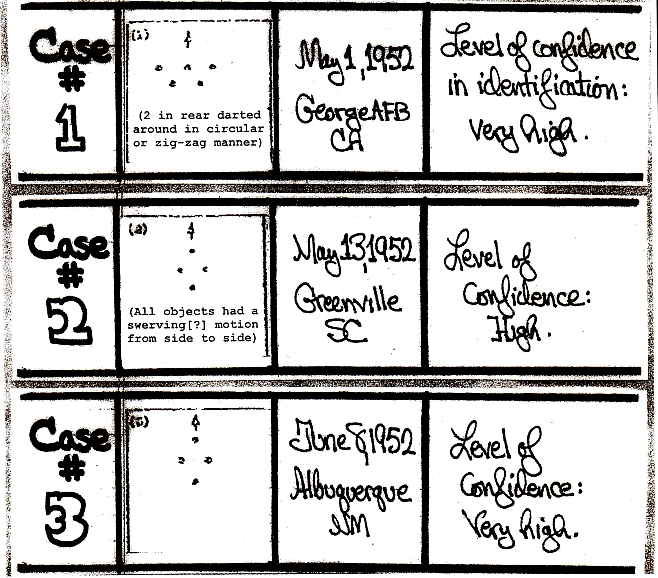
Not in Blue Book, but in Fournet. How does that happen? This event was witnessed by Doyle Kline, a staff writer for Scripps-Howard resident in Albuquerque. He doubtless had plenty of interactions with the local Air Force base (Kirtland) and he knew the base commander, Brig. Gen. William A. Matheny. The witness went directly to Matheny and reported his sighting (we know this because Kline wrote the story up for a Scripps-Howard news dispatch). Matheny wouldn't comment on his opinions of UFOs to Kline, but we know what he believed. This is because Ruppelt knew him, too. Ruppelt categorized Matheny as one of the base commanders most sold on the idea that UFOs were extraterrestrial craft. Matheny suggested to Kline that he meet with base intelligence officers and make out a full report. This he did, and this is the report we cannot find.
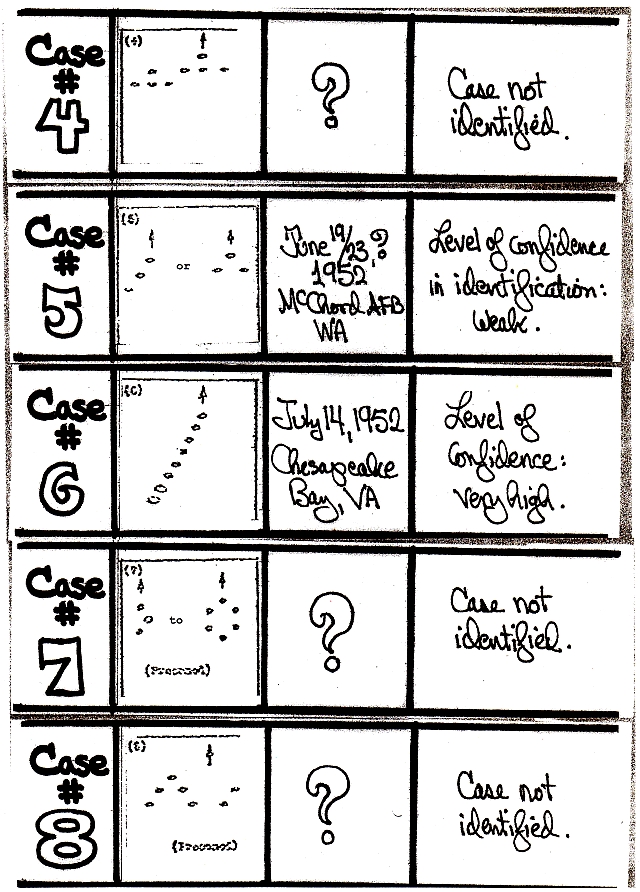
There were (most likely) multiple report copies, as was policy at that time. One would likely go to Air Defense command headquarters. One would definitely go to the Directorate of Intelligence and land on Fournet's desk. One would probably be filed at Kirtland (especially with a commander like Matheny), and one may or may not have been sent directly to Blue Book. Why not certainly? Well, there was a lot of confusion at the individual bases as to whether to send copies to Blue Book or not. One policy was to send everything to the Pentagon and they would pass on the information in a timely manner. Whatever happened in this case, Dewey got the report, and it seems Blue Book didn't. A deduction one might make is that this probably happened more than once, and that a pile of untransferred cases exist at both Air Defense Command and the Directorate of Intelligence that we have never seen.
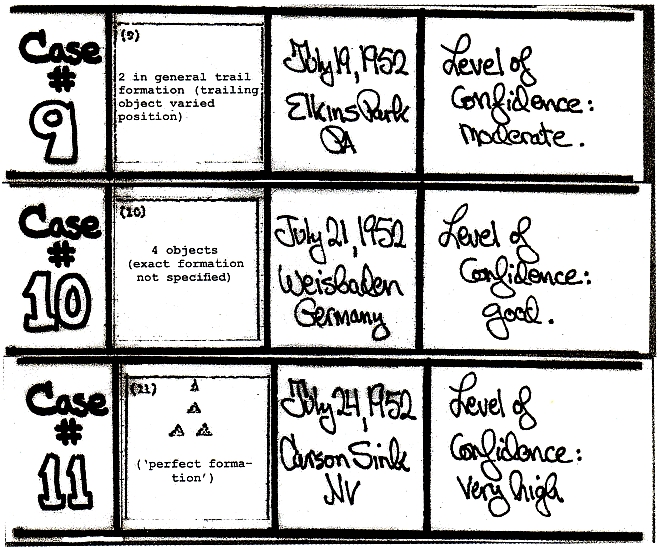
In this instance, more oddity exists since it is almost certainly also true that Ruppelt did see the case when in D.C. and arguing with Fournet about the validity of his study. Our boy Ed mentions several motion-study cases by name here and there in his archival notes. The incompetency of the case transfer may have been due to everyone being too busy and hassled or to incompetent handling of Blue Book duties when the boss (Ruppelt) had to be so frequently out of town. (I have several hints that the younger personnel backing up Ruppelt didn't take their tasks seriously.)
More important than all this organizational stuff and sociology is what Dewey Fournet was trying to tell us. He saw right through the phenomenon. He was a pilot who watched countless airplanes at work and he knew something very simple: Groups of planes in military formation don't look like anything else. They don't look like balloons, or fireballs, or illusions. They don't even look like geese. The hard geometry of planes in formation is unique, and in some sense, looks unnatural. It is the result of intelligence at work combined with technology. All you have to know about the nature of UFOs, as a first deduction, is contained in any set of cases involving formations. Once you clearly see that those cases at least are of intelligently controlled technology, then you must ask yourself: Can we fly like that? Fournet's answer was no, we can't. This, in a less formalized way, is still the basis for the pro-ETH argument today. One can escape its logic only by creating (to my mind, preposterous) schemes to deny the details of the reports, or have the unusual mind of Ed Ruppelt, who could see exactly what Fournet saw and still feel that somehow none of that was good enough, because people were flawed as witnesses (even when honest) and he really needed a wreck of one to inspect before he could conclude anything.

Ruppelt again:
On my next trip to the Pentagon, I spent the whole day talking to Major Dewey Fournet and two of his bosses, Colonel W. A. Adams and Colonel Weldon Smith, about the UFO subject in general. One of the things we talked about was a new concept or approach to the UFO problem — that of trying to prove that the motion of a UFO as it flew through the air was intelligently controlled....
The basic principle of the study would be to see if the motion of the reported UFOs was random or ordered. Random motion is an unordered helter-skelter motion very similar to a swarm of ants or flies mulling around. [Ruppelt then goes on to class bird flights as ordered due to their “intelligence,” but he does not quite grasp the subtlety of what Fournet was trying to do.]
By the fall of 1952 we had a considerable number of well documented reports in which the UFOs make a series of maneuvers. If we could prove that these maneuvers were not random, but ordered, it would be proof that the UFOs were something that was intelligently controlled.
Ruppelt understood almost everything driving Fournet, Adams, and Smith (except for the point that the hard geometry of machine-powered flight involves behavior different from bug-hunting swallows). But he also did us a real service. He mentioned a couple of sightings that he said were being used but are not in the study under discussion.
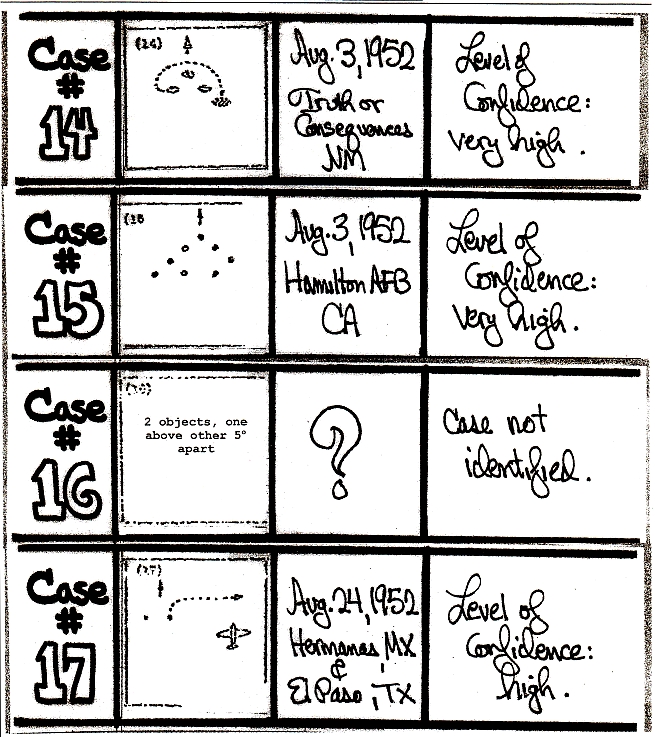
I believe that this last fact is because Fournet knew that flying in formation alone wasn't enough for the ETH. To get all the way there you need another set of cases that demonstrate maneuvering beyond the operational capabilities of U.S. or Soviet aircraft in 1952. These additional studies could be based on well-documented cases even if those had only a single object with no formation flying. It is my suspicion that Fournet's motion study was of two types: advanced maneuvering and formation flying. When taken together, they made (for him) the ETH hard to deny. Neither of the two cases mentioned in Ruppelt's book, but not in Fournet's study, are formation-flying events, but both would fall into the other half of the study. Fournet would only have handed out a set of diagrams for the formation cases because drawing out all the motions in the maneuvers cases was (should have been, anyway) far more complicated. It is also my belief that the UFO motions in the Tremonton, Utah, film played a big role in his study, but since the Navy analysts were at the panel to talk that through, Fournet didn't have to do so. Fournet, concerning his study:
I prepared it primarily as a weapon for use against the apathy and/or bias on the subject which prevailed in certain official quarters.
And:
It contained largely the same kind of data [that I used in] the presentation to the Robertson Panel. What I did was use the same basic sighting reports, intending to show the probability of intelligent control — probability in this case — and admitting to the possibility that when we said that intelligent control is probable [we have to] admit then the further possibility that they could be of extraterrestrial origin.
Well, old UFO warrior, I'm with you on all of that, and tip my hat to you because you saw so clearly, even without the help of the mountain of close-encounter cases that were yet to come.
FOURNET CASE IDENTIFICATIONS
Case #1, May 1, 1952, George Air Force Base, near Victorville, California. Five Air Force witnesses saw five white discs; objects flew in formation, but the last two would close, then break apart; the group made a right-angle turn.
Case #2, May 13, 1952, Greenville, South Carolina. Four astronomers at Furman University witnessed four red-yellow ovals; objects flew in diamond formation and wobbled; the case was cleared for Donald Keyhoe by Fournet and Al Chop.
Case #3, June 8, 1952, Albuquerque, New Mexico. Two civilian witnesses at the Monte Vista Christian Church saw four shiny ovals; objects flew in diamond formation, straight and level; Fournet and Kirtland Air Force Base Commander Brig. Gen. William A. Matheny seemed to have a close interest in local UFO reports, and this could explain this case's inclusion.
Case #4, not yet identified.
Case #5, June 17, 19, 23, 1952, McChord Air Force Base, near Tacoma, Washington. Multiple Air Force witnesses saw yellow-white objects on three separate nights; variable numbers, objects sometimes in a "V," maneuvered as a group. This case identification is possible but weak.
Case #6, July 14, 1952, Chesapeake Bay, Virginia. A Pan American Airways DC-4 airliner was flying southward along the east coast at 8,000 feet; Capt. William B. Nash and Second Officer William Fortenberry suddenly saw six reddish, glowing ovals in clear formation making a strange, non-inertial turning maneuver.
Case #7, not yet identified. However, and intriguingly, this could be the first of the famous Washington, D.C., radar sightings on July 19,1952; variable numbers of objects were seen, as many as seven at once; Fournet could be including this because of his first-hand knowledge of the radar returns.
Case #8, not yet identified.
Case #9, night of July 19-20, 1952, Elkins Park, Pennsylvania. An Air Force pilot watched two star-like objects that circled in formation and made right-angle turns (outstanding description of sighting); shortly afterwards, two other sets of observers, one at Lavallette, New Jersey, and another on a cruiser off the New Jersey coast, reported similar objects.
Case #10, July 21, 1952, Wiesbaden, Germany. Two Air Force officers in different locations saw four yellow-white lights, turning red; the objects flew in a straight line, hovered, then formation broke as two went high, one west, and one east.
Case #11, July 24,1952, Carson Sink, Nevada. Two Air Force lieutenant colonels in a B-25 saw three silver-white, delta-shaped objects that approached to within 400-800 yards; they banked and turned in formation.
Case #12, July 27, 1952, Manhattan Beach, California. An ex-Navy pilot and seven other witnesses saw one large silver object; it turned and split into several coin-shaped disks that formed a stack in the sky; the assemblage circled and flew off.
Case #13, July 30, 1952, Albuquerque, New Mexico. Scripps-Howard reporter Doyle Kline saw about 10-12 objects; they were white and luminous and flew in a cluster, then shifted to a V formation, and then into two parallel lines, slightly offset from each other; this could be another report from Matheny to Fournet involving civilian observations. [A strong possibility exists that this sighting occurred on July 29, as Kline's report apparently was first published in the Albuquerque Tribune on July 30, in which he stated that the event occurred the previous night. –Ed.]
Case #14, August 3, 1952, Truth or Consequences, New Mexico. A civilian engineer saw three light-green cylinders; the objects hovered in an inverted V formation, then one rolled over to create an echelon formation; they seemed to rotate around an axis as they flew; this is also a case cleared for Keyhoe by Fournet and Chop.
Case #15, August 3, 1952, Hamilton Air Force Base, near Novato, California. Three Air Force officers saw two silver discs, then six more; the objects maneuvered and circled, then when six more arrived, assumed a diamond-like pattern.
Case #16, not yet identified.
Case #17, August 24, 1952, from Hermanas, New Mexico, to El Paso, Texas. An Air National Guard colonel, flying an F-84G from California to Georgia, saw two silver balls; the objects flew in formation, but one seemed to change shape to oval or longer when it made a right-hand turn; both turned to gray in color; after disappearing, they rejoined the plane over El Paso; one object went high and the other flew to join in close formation; then they flew off; this is another case cleared for Keyhoe.
|
|
|
|